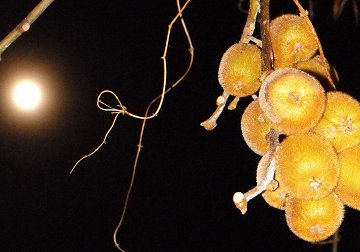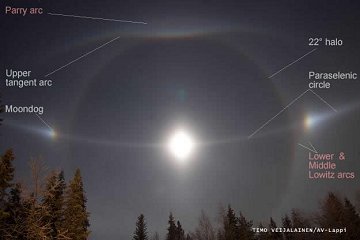SPACESHIP SIGHTINGS: Would you like a call when the space station is about to fly over your backyard? Sign up for Spaceweather PHONE. | | | SOLAR MINIMUM: The sun is in the pits of a very deep solar minimum. Many researchers thought the sunspot cycle had hit bottom in 2008 when the sun was blank 73% of the time. Not so. 2009 is on the verge of going even lower. So far this year, the sun has been blank 75% of the time, and only a serious outbreak of sunspots over the next few weeks will prevent 2009 from becoming the quietest year in a century. Solar minimum continues. LONG NIGHT'S MOON: Last night, observers around the world enjoyed the bright light of the full "Long Night's Moon." In the Netherlands, the moonlight revealed a bunch of frosty kiwis hanging in the back garden of photographer Jacob Kuiper: 
"November of 2009 was the 2nd warmest November since 1901,"
says Kuiper. "Because of this spring-like weather, my kiwifruit was still hanging in place when December brought our first frost--and a lovely full Moon." The question is, will they still be hanging when the second full Moon of December arrives? This month has two full Moons--the Long Night's Moon of Dec. 1st-2nd and a rare "Blue Moon" on Dec. 31st. Check back then for updates, and meanwhile browse the links below. more images: from Mark Riddick of Staunton, Virginia; from Stefano De Rosa of Turin, Italy; from Mike Deep of San Antonio, TX; from Derek Weston of Iowa City, IA; from Rick Ellis of Toronto, Canada; from John C McConnell of Maghaberry Northern Ireland; from P-M Hedén of Vallentuna, Sweden; from Enrico Finotto of Health of Livenza, Venice, Italy; from Doug Zubenel of Lenexa, Kansas; from Steve Cotthaus of Virginia Beach, VA; from Alexandros Diamantis of Athens, Greece; RARE MOON HALOS: On Nov. 29th, when the waxing Moon ascended over Kittilä, Finland, Timo Veijalainen walked outside and witnessed a once-in-a-lifetime moonrise. "I saw this weird halo," he says. "It didn't start out so bright, but later it intensified and formed a number of different rings. I've never seen anything it!" Fortunately, he was not too spellbound to take a picture: 
The display was caused by ice crystals floating in the air between Finland and the Moon. Moonlight glinted, reflected, and refracted through the crystals in a complicated pattern that produced a display of surpassing beauty. Atmospheric optics expert Les Cowley was so impressed, he waxed poetic in describing the scene: "Halos like this around Helios, the ancient Greek sun god, would be notable. Around much fainter Selene, the moon goddess, they are outstanding. We need new names for some of them. On each side of Selene there is a bright and colorful moondog or 'paraselene.' The white halo joining them and passing through the moon is a 'paraselenic circle.'" "But the two choicest gems illuminated by Selene keep their old names. The very topmost halo is a rare one. It remains a Parry arc in honor of its discoverer the Arctic explorer William Parry, who first saw it around the sun. That's not all. The smudges near the moondogs are very rare lower and middle Lowitz arcs. These were not even photographed around Helios until the 1990s!"
November Northern Lights Gallery
[previous Novembers: 2008, 2007, 2006, 2004, 2003, 2002, 2001]
Explore the Sunspot Cycle | 
